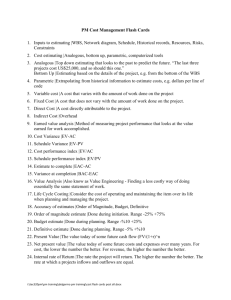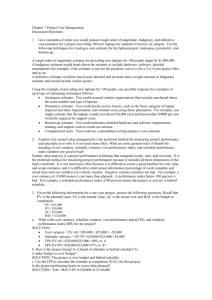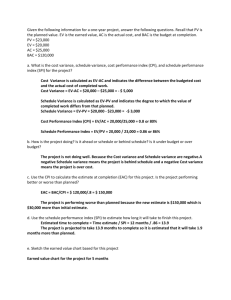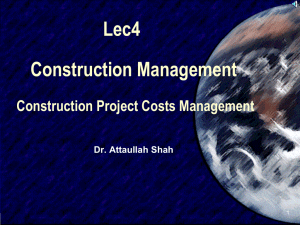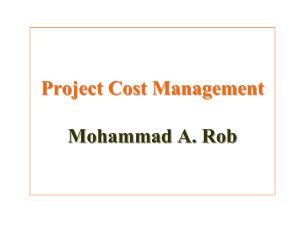PMP Mock Questions
advertisement
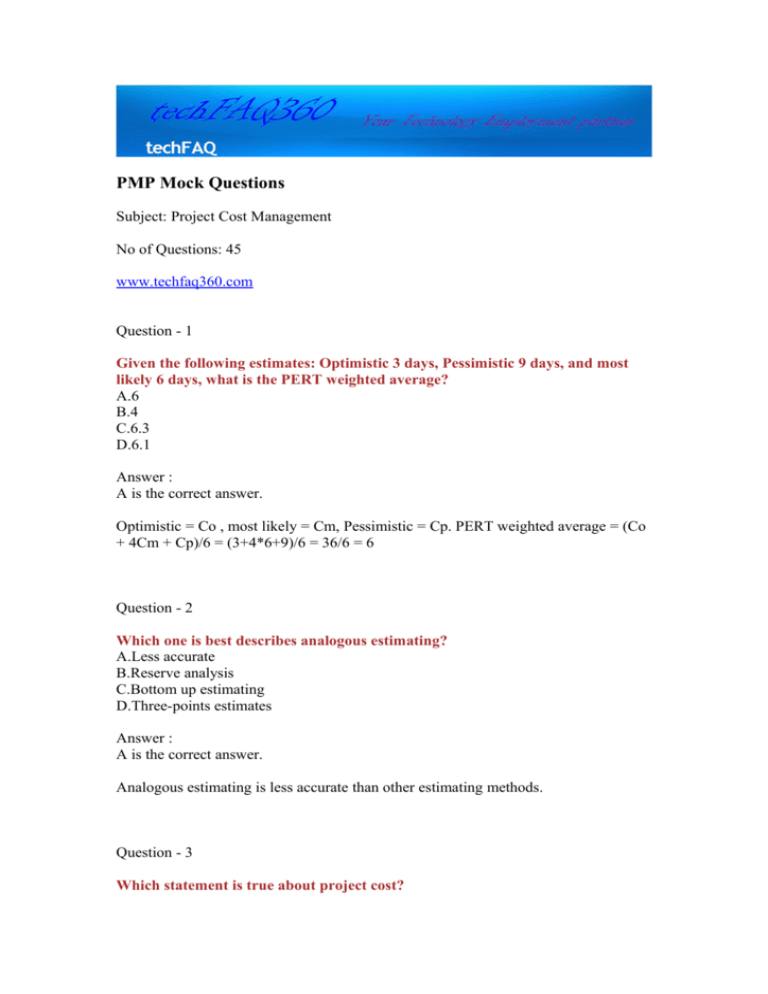
PMP Mock Questions Subject: Project Cost Management No of Questions: 45 www.techfaq360.com Question - 1 Given the following estimates: Optimistic 3 days, Pessimistic 9 days, and most likely 6 days, what is the PERT weighted average? A.6 B.4 C.6.3 D.6.1 Answer : A is the correct answer. Optimistic = Co , most likely = Cm, Pessimistic = Cp. PERT weighted average = (Co + 4Cm + Cp)/6 = (3+4*6+9)/6 = 36/6 = 6 Question - 2 Which one is best describes analogous estimating? A.Less accurate B.Reserve analysis C.Bottom up estimating D.Three-points estimates Answer : A is the correct answer. Analogous estimating is less accurate than other estimating methods. Question - 3 Which statement is true about project cost? A.Costs associated with projects are not just the costs of goods procured to complete the project. B.The cost of the labour may be one of the biggest expenses of a project. C.The cost of the equipment and materials needed to complete the project work must be factored into the project expenses. D.All of the above Answer : D is the correct answer. All are true Question - 4 If You are the project manager for a Project. You are about to create the cost estimates for the project. Which of the following inputs help you? A.Scope baseline B.Human Resource Plan C.Risk register D.All of the above Answer : D is the correct answer. Input of Estimate Costs are : Scope baseline, Human Resource Plan ,Risk register , Organizational process assets and Enterprise environmental factors. Question - 5 Which statement is true about Bottom-up estimating ? A.Estimating the cost of individual work items and then rolling up the costs to arrive at a project total . B.Uses the actual cost of a previous, similar project as the basis for estimating the cost of the current project. C.Both of the above true D.None of the above Answer : A is the correct answer. Estimating the cost of individual work items and then rolling up the costs to arrive at a project total . It is more accurate. Question - 6 If you have elected to use parametric modelling in your Estimate Costs for the project. Which one of the following is an example of parametric modelling? A.$120 per kg B.Historical information from a similar project C.Estimates built from bottom-up based on the WBS D.Estimates based on top-down budgeting Answer : A is the correct answer. A is correct; $120 per ton is an example of parametric modelling. Parametric modelling : Using project characteristics (or parameters) in a mathematical model to predict costs (e.g., price per square foot). B is incorrect, as historical information is analogous, not parametric. C is incorrect, Bottom-up estimating is not parametric modelling. and D is incorrect, top-down budgeting is related to Analogous estimating . Question - 7 Which estimating technique is most accurate? A.Bottom-up estimating. B.Analogous estimating. C.Parametric modeling. D.None of the above Answer : A is the correct answer. Bottom-up estimating : Estimating the cost of individual work items and then rolling up the costs to arrive at a project total . It is more accurate. Question - 8 Your company has been hired to configure software in 500 computers. All computer need equal time to configure. You calculate the time to configure each computer as 5 hours. The cost for labour for is calculated at $500 each computer. Your Project Sponsor disagrees with your labour estimate. Why? A. You haven't completed one computer yet so you don't know how long the work will actually take. B. You have not factored in all of the effort applied to the work. C. You have not considered the law of diminishing returns. D. You have not considered the learning curve. Answer : D is the correct answer. D is the best choice. As the project team completes more and more units, the time to configure a computer should take less and less time. Question - 9 Your company has been hired to configure software in 500 computers. All computer need equal time to configure. The contract for the project is set at a fixed cost, the incentive being the faster the project work is completed, the more the profitable the job. Management has requested that you study the work method to determine a faster, less costly, and better method to complete the project. This is an example of which one of the following? A.Time constraint B.Schedule constraint C.Value analysis D.Learning curve Answer : C is the correct answer. Value analysis is a systematic approach to find less costly ways to complete the same work. A and B are incorrect, as this situation does not describe a specific time or cost constraint. D is incorrect, as the learning curve happens as the project team completes the work. Question - 10 If you are the project manager for a project. The customer has requested that you factor after-project costs, such as maintenance and service. This is an example of which one of the following? A.Life cycle costs B.Scope creep C.Project spin off D.Operations Answer : A is the correct answer. The after-project costs are known as the life cycle costs. Question - 11 Which provides the least accurate in estimating? A.Rough order of magnitude B.Budget estimate C.WBS estimate D.Definitive estimate Answer : A is the correct answer. The rough order of magnitude is the least accurate approach, as it may vary from -25 percent to +75 percent. Question - 12 You have just started a project. Project team member reports 20 percent done with the project. You agree with their completion status but do not change any of the progress in your report to the customer. This is an example of which one of the following? A.0/100 rule B.50/50 rule C. Percent Complete Rule D.None of the above Answer : A is the correct answer. The 0/100 rule : allows for zero percent credit on an activity until it is 100 percent complete. B is wrong , 50/50 rule, 50 percent completion when the work begins and 50 percent when the work is completed. Question - 13 If you have elected to use bottom-up estimating and will base your estimates on the WBS. Which one of the following is not an attribute of bottom-up estimating? A.Less expensive to do than other methods of estimations B.More expensive to do than other methods of estimations C.Creates a more accurate estimate D.People doing the work create the estimates Answer : A is the correct answer. bottom-up estimating is not less expensive. It is accurate. Estimating the cost of individual work items and then rolling up the costs to arrive at a project total - more accurate. Question - 14 What is the present value if the organization expects to make $500,000 three years from now and the annual interest rate is 4 percent? A.$4000 B.$5000 C.$25000 D.None Answer : A is the correct answer. Present Value = FV/(1+R)n. FV is the future value, R is the interest rate, and n is the number of time periods. 500000/(5*5*5) = 4000 Question - 15 You are the project manager for the construction of a new Building. Before you begin the Determine budgeting process, which of the following inputs help you? A.Activity Costs estimates and project schedule B.Scope baseline C.Contracts D.All of the above Answer : D is the correct answer. Determine budget : Inputs : Activity Costs estimates and project schedule ,Scope baseline , Contracts, Basis of estimates and Organizational process assets. Question - 16 Which of the following is the output of Determine Budget ? A.Cost performance baseline B.Project Funding Requirements C.Project document updates D.All of the above Answer : D is the correct answer. Output of Determine Budget is : Cost performance baseline, Project Funding Requirements and Project document updates. Question - 17 Which of the following are inputs of Estimate Costs ? A.Risk register B.Human Resource Plan C.Scope baseline D.All of the above Answer : D is the correct answer. Input of Estimate Costs are : Scope baseline, Human Resource Plan ,Risk register , Organizational process assets and Enterprise environmental factors. Question - 18 You are the project manager of a Project. Your project will cost your organization $50,000 to complete over the next 3 months. Once the project is completed, the deliverables will begin earning the company $5000 per month. What is the time to recover the costs of the project ? A.10 months B.1 year C.2 years D.3 years Answer : A is the correct answer. This is calculated by dividing the ROI of $5000 per month into the project cost. 50000/5000 = 10 months Question - 19 You have two possible projects to manage, but you can only choose one. Project MKTG is worth $23,000, while Project SALESPTR is worth $25,000. Management elects to choose Project SALESPTR. The opportunity cost of this choice is which one of the following? A.$23,000 B.$27,000 C.$50,000 D.$4000 Answer : A is the correct answer. The opportunity cost is the amount of the project that was not chosen. Question - 20 If you want to print mote than 25000 workbooks, printing of workbooks may be go up to 50000 workbooks . For every 5000 workbooks created the cost is reduced a percentage of the original printing cost. The workbook expense is an example of which one of the following? A.Fixed costs B.Parametric costs C.Variable costs D.None of the above Answer : C is the correct answer. This is an example of variable costs. Question - 21 You are the project manager of a project scheduled to last 18 months. You have elected to rent a piece of equipment for the duration of a project, even though you will need the equipment only for 6 months. The costs of the equipment rental per month are $120. This is an example of ___________ ?. A.Fixed costs B.Parametric costs C.Variable costs D.None of the above Answer : A is the correct answer. This is an example of Fixed costs because $120 per month is fixed. Question - 22 You have a piece of equipment that was purchased for your project recently for $5,000 and is expected to last 5 years in production. At the end of the five years the expected worth of the equipment is $2,000. Using straight-line deprecation, what is the amount that can be written off each year? A.$600 B.$1200 C.$3000 D.Zero Answer : A is the correct answer. The straight-line depreciation takes the purchase value of the item, minus the salvage price of the item, divided by the number of time periods. Calculation is (5000-2000)/5 = $600 Question - 23 You are the project manager of the MKTG Project. The project has a budget of $200,000 and is expected to last 2 years. The project is now 20 percent complete and is on schedule. What is the BAC? A.$200,000 B.$200,00 C.$50,000 D.$60,000 Answer : A is the correct answer. The BAC is the budget at completion(Total budgeted cost), which is $200,000. Question - 25 You are the project manager of the AC Installation Project for a new building. Your BAC is $500,000. You are now 50 percent done with the project, though your plan called for you to be 55 percent done with the work at this time. What is your earned value? A.$250,000 B.$275,000 C.$500,000 D.$345,000 Answer : A is the correct answer. The earned value is calculated by multiplying the percentage of completion, 50 percent, by the BAC, which is $500,000, for a value of $250,000. Question - 26 You are the project manager of the AC Installation Project for a new building. Your BAC is $500,000. You have spent $270,000 of your budget. You are now 50 percent done with the project, though your plan called for you to be 55 percent done with the work at this time. What is CPI? A..92 B..82 C..72 D..45 Answer : A is the correct answer. CPI = EV / AC Earned Value/ Actual Cost The EV of $250,000 is divided by the AC of $270,000 for a value of .92. Question - 27 Which of the following are part of Project Cost Management? A.Estimate Costs B.Determine Budget C.Control Costs D.All of the above Answer : D is the correct answer. There are following processes which are part of Project Cost Management. Estimate Costs , Determine Budget and Control Costs Question - 28 Which statement is true about Project Scope Statement? A.The project scope statement describes the business need,justification, requirements, and current boundaries for the project. B.It provides important information about project requirements that is considered during Estimate Costs. C.Contains project justification and the project objectives, which need to be considered. D.All of the above Answer : D is the correct answer. Project Scope Statement: The project scope statement describes the business need,justification, requirements, and current boundaries for the project. It provides important information about project requirements that is considered during Estimate Costs Question - 29 Which statement is true about Work breakdown structure (WBS) ? A.Identifies the project elements that require resources. B.Used to organize the cost estimates and to ensure that the cost of all identified work has been estimated. C.The project work breakdown structure (WBS) provides the relationship among all the components of the project and the project deliverables. D.All of the above Answer : D is the correct answer. Work breakdown structure (WBS) : Identifies the project elements that require resources. Used to organize the cost estimates and to ensure that the cost of all identified work has been estimated. The project work breakdown structure (WBS) provides the relationship among all the components of the project and the project deliverables. Question - 30 Which of the following is the output of Estimate Costs process? A.Activity cost estimates B.WBS C.Project Scope Statement D.Cost performance baseline Answer : A is the correct answer. Output of Cost Estimation is Activity cost estimates. Question - 31 Which statement is true about Control Costs ? A.Influencing the factors that create changes to the cost baseline. B.Monitoring cost performance to detect variances from the plan. C.Recording all appropriate changes accurately against the cost baseline D.All of the above Answer : D is the correct answer. All of the above Question - 32 Which of the below statment is true? A.Budget At Completion (BAC): The estimated total cost of the project when done. B.Actual Cost (AC): AC is the total cost incurred in accomplishing work on the schedule activity or WBS component during a given time period. C.Determine Budget: Allocating the cost estimates to individual project components. D.All of the above Answer : D is the correct answer. Budget At Completion (BAC): The estimated total cost of the project when done. Actual Cost (AC): AC is the total cost incurred in accomplishing work on the schedule activity or WBS component during a given time period. Determine Budget: Allocating the cost estimates to individual project components. Question - 33 Which of the below statement is true about Cost Performance Index (CPI)? A.CPI = EV (Earned Value) / AC (Actual Cost) B.If CPI is less than 1, this means that the project is over budget. C.Both of the above are true. D.None of the above Answer : C is the correct answer. CPI = EV (Earned Value) / AC (Actual Cost) If CPI is less than 1, this means that the project is over budget. Question - 34 Which of the below statement is true about Cost Variance (CV)? A.Any difference between the estimated cost of an activity and the actual cost of that activity. B.Negative CV , this means that the project is over budget. C.Both of the above are true. D.None of the above Answer : C is the correct answer. Any difference between the estimated cost of an activity and the actual cost of that activity. Question - 35 Which of the below statement is true about Earned Value (EV)? A.It compares the amount of work that was planned with what was actually accomplished to determine if cost and schedule performance is as planned. B.Earned Value (EV) is the physical work completed to date and the authorized budget for that. C.It is also called as BCWP (Budgeted Cost of Work Performed). D.All of the above Answer : D is the correct answer. It compares the amount of work that was planned with what was actually accomplished to determine if cost and schedule performance is as planned. Earned Value (EV) is the physical work completed to date and the authorized budget for that. It is also called as BCWP (Budgeted Cost of Work Performed). Question - 36 Which statement is true ? A.Schedule Variance (SV): Any difference between the scheduled completion of an activity and the actual completion of that activity. B.Cost Variance (CV): Any difference between the estimated cost of an activity and the actual cost of that activity. C.Schedule Performance Index (SPI): The ratio of work performed to work scheduled. D.All of the above Answer : D is the correct answer. Schedule Variance (SV): Any difference between the scheduled completion of an activity and the actual completion of that activity. Cost Variance (CV): Any difference between the estimated cost of an activity and the actual cost of that activity. Schedule Performance Index (SPI): The ratio of work performed to work scheduled. Question - 37 Which statement is true about Schedule Variance? A.Schedule Variance (SV): Any difference between the scheduled completion of an activity and the actual completion of that activity. B.A negative result means less work has been performed than was planned. C.Both of the above are true D.None of the above Answer : C is the correct answer. Schedule Variance (SV): Any difference between the scheduled completion of an activity and the actual completion of that activity. SV = EV - PV Question - 38 If you are a project manager of a project. Till today you have actually completed $34,000 of work and based on the cost plan it should be $50,000. What is Schedule Variance (SV) ? A.-$16,000 B.$16,000 C.$34,000 D.$23,000 Answer : A is the correct answer. Schedule Variance (SV): Any difference between the scheduled completion of an activity and the actual completion of that activity. SV = EV - PV SV = $34,000 $50,000 = -$16,000 Question - 39 If you are a project manager of a project. Till today you have actually completed $34,000 of work and based on the cost plan it should be $50,000. What is percentage Schedule Variance (SV) ? A.-32% B.-16% C.32% D.None of the above Answer : D is the correct answer. Schedule Variance (SV): Any difference between the scheduled completion of an activity and the actual completion of that activity. SV % = (EV - PV)/PV SV % = ($34,000 - $50,000)/$50,000 = -32% Question - 40 Your project has a budget of $240,000 and is expect to last 1 year, with the work and budget spread evenly across all months. The project is now in month four, the work is on schedule, but you have spent $120,000 of the project budget. What is your COST variance? A.-$40,000 B.$40,000 C.$240,000 D.None of the above Answer : A is the correct answer. Cost Variance = Earn Value - Actual Cost Earn Value = (Total Cost/total project months) * total months completed = ($240,000/12)*4=$80,000 CV = $80,000 $120,000 = -$40,000 Question - 41 Your project has a budget of $240,000 and is expect to last 1 year, with the work and budget spread evenly across all months. The project is now in month four, the work is on schedule, but you have spent $120,000 of the project budget. What is your COST variance percentage? A.-50% B.50% C.40% D.None of the above Answer : A is the correct answer. Cost Variance = Earn Value - Actual Cost Earn Value = (Total Cost/total project months) * total months completed = ($240,000/12)*4=$80,000 CV = $80,000 $120,000 = -$40,000 CV % = CV / EV = -$40,000/$80,000 = -50% Question - 42 Your project has a budget of $240,000 and is expect to last 1 year, with the work and budget spread evenly across all months. The project is now in month four, But actual work completed is 20% of the total work. . What is Schedule Performance Index (SPI)? A.1.66 B.1 C.2.5 D.1.9 Answer : A is the correct answer. Schedule Performance Index (SPI) = Earn Value/Planned Value Earn Value = (Total Cost/total project months) * total months completed = ($240,000/12)*4=$80,000 Planned Value = Total Cost * percentage actually completed = $240,000 * 20/100 = $48,000 SPI = $80,000/$48,000 = 1.66 Question - 43 Your project has a budget of $10,000 and is expect to last 1 year, with the work and budget spread evenly across all months. Right now CPI is 0.8 . What is Estimate at Completion (EAC)? A.$12,500 B.$10,000 C.2.5 D.3.0 Answer : A is the correct answer. Estimate at Completion (EAC) = BAC/CPI = $10,000 / .8 = $12,500 Question - 44 Your project has a budget of $10,000 and is expect to last 1 year, with the work and budget spread evenly across all months. Right now CPI is 0.8 . What is Variance at Completion? A.-$2,500 B.$10,000 C.$12,500 D.$12,000 Answer : A is the correct answer. Variance at Completion = BAC - EAC Estimate at Completion (EAC) = BAC/CPI = $10,000 / .8 = $12,500 Variance at Completion = $10,000 - $12,500 = -$2,500 Question - 45 Your project has a budget of $12,000 and is expect to last 1 year, with the work and budget spread evenly across all months. The project is now in month four, But till now total spending for this project is $5,000. What is Variance at Completion? A.-$3,000 B.-$5,000 C.$12,000 D.$13,000 Answer : A is the correct answer. Earn Value = (Total Cost/total project months) * total months completed = ($12,000/12)*4=$4,000 Variance at Completion = BAC - EAC CPI = EV (Earned Value) / AC (Actual Cost) = $4000/$5000 = .8 Estimate at Completion (EAC) = BAC/CPI = $12,000 / .8 = $15,00 Variance at Completion = $12,000 - $15,000 = $3,000 All the materials are Copyrights © www.techfaq360.com , please don't share .
